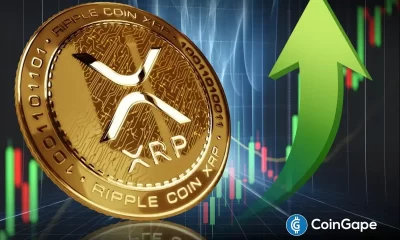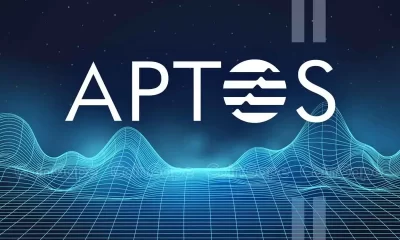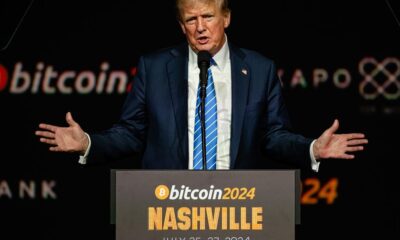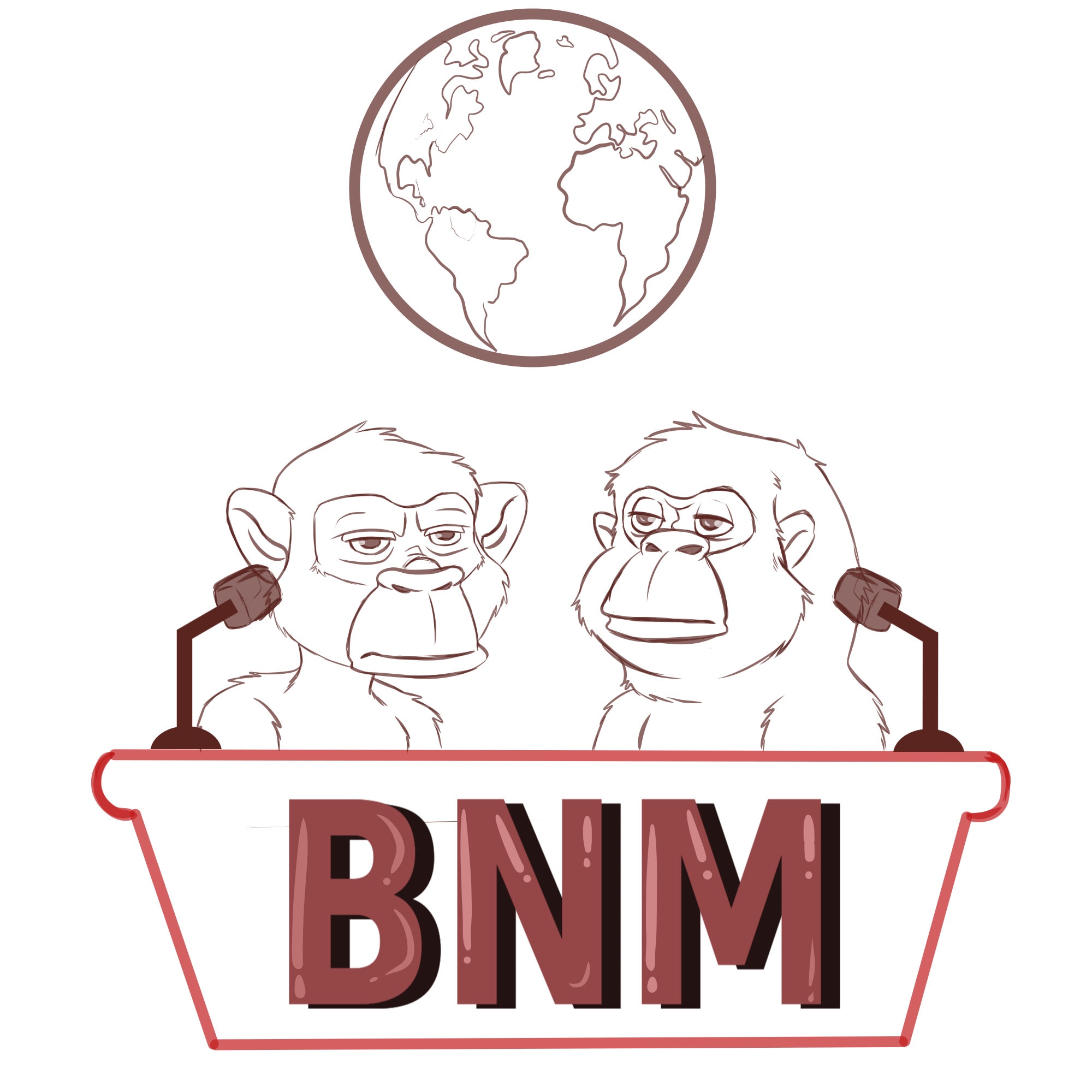debt
US Treasury Adds $104,000,000,000 To National Debt in One Day As Total Outstanding Debt Shatters Record High at $35,951,000,000,000
Published
6 months agoon
By
admin
The US national debt just hit a new record high after the Treasury Department added $104 billion to its outstanding balance in a single day.
The Treasury’s Debt to the Penny database shows the government’s pile of debt is close to $36 trillion, clocking in at $35.951601173936 trillion.
The US shattered the $35 trillion barrier in late July.
The grim milestone comes as a study from the nonpartisan Committee for a Responsible Federal Budget shows both presidential candidates will add trillions more to the national debt.
The CRFB says a Harris presidency could add $3.5 trillion to the debt over ten years, while a Trump presidency could add 7.75 trillion in the same time frame.
However, the agency warns its models have a wide range of possible spending outcomes.
“Our estimates come with a wide range of uncertainty, reflecting both different interpretations and estimates of the policies.
Under our low- and high-cost estimates, we estimate Vice President Harris’s plan could increase debt by between $300 billion and $8.30 trillion through 2035, while President Trump’s plan could increase debt by between $1.65 and $15.55 trillion.”
The agency says its estimates reflect the “expected fiscal impact” of the policies that the candidates have laid out on their campaign websites, official announcements, white papers and social media posts.
“The national debt currently stands at 99% of Gross Domestic Product (GDP) and is projected to grow from 102% of GDP at the start of FY 2026 to 125% by the end of 2035 based on the Congressional Budget Office’s (CBO) current law baseline.
The debt will exceed its record as a share of the economy – 106% set in 1946 – in just three years. Debt would continue to grow faster than the economy under either candidates’ plans and in most scenarios would grow faster and higher than under current law.”
Don’t Miss a Beat – Subscribe to get email alerts delivered directly to your inbox
Check Price Action
Follow us on X, Facebook and Telegram
Surf The Daily Hodl Mix
 

Disclaimer: Opinions expressed at The Daily Hodl are not investment advice. Investors should do their due diligence before making any high-risk investments in Bitcoin, cryptocurrency or digital assets. Please be advised that your transfers and trades are at your own risk, and any losses you may incur are your responsibility. The Daily Hodl does not recommend the buying or selling of any cryptocurrencies or digital assets, nor is The Daily Hodl an investment advisor. Please note that The Daily Hodl participates in affiliate marketing.
Generated Image: Midjourney
Source link
You may like


Ethereum Foundation shuffles leadership, splits board and management


Bitcoin Price (BTC) Retakes $95K Level After Early U.S. Decline


A New Risk For The Industry?


Justin Sun Bets Big On JUST Token, Sees 100x Potential


Worldcoin price prediction | What’s next for WLD price?


Bitcoin Is About To Begin Outperforming Gold, Says InvestAnswers – Here’s His Timeline
David Graeber
Debt: Bitcoin Is Not A Return To Stateless Money, It Is the First
Published
4 months agoon
December 27, 2024By
admin


I have just finished reading Debt: The First 5000 Years by anthropologist David Graeber. The book takes a look at the history of money, debt, and how they relate to societal structures from a lens that departs heavily from the conventional wisdom of economic thinking.
Conventional wisdom paints a picture of people inefficiently bartering goods and services directly for each other, and money naturally arising as a result of the problems inherent in this. Graeber eviscerates this narrative looking at anthropological history. Primitive communities simply shared their resources freely with each other, living in a communal lifestyle, with bartering rarely taking place, and only in the context of separate communities interacting with each other. It played no role in early societies’ intra-communal affairs.
Money, as in commodity money, only began to be used in rare inter-communal interactions across great distances. The economy in local regions did not begin using such mechanisms for exchange. They used credit. Credit operated and overseen by the government, such as in Ancient Sumer. This system grew out of the informal “credits” people considered when sharing resources in more primitive societies. But it was formalized and maintained by the power structure of the government and temples of Sumer. No money would change hands during exchanges, people would simply record debts stored at the temple, and periodically settle their obligations with actual consumable commodities.
Debt came before coinage, and it was created and maintained at scale by the state. Commodity money only came later, again minted and circulated by the state, as large scale trust based civilizations collapsed and gave way to warring imperial states. Debt and credit do not make much sense in a time period of constant war and roving armies, with no certainty at all they will ever return to settle debts after moving on.
Ever since, with the anomaly of the modern era and central banks, human societies have oscillated between virtual credit money and coinage depending on whether or not the era of the time was predominantly predicated on large scale war and conquest. The same patterns repeated through the ages as well, with people creating their own informal and localized credit networks after large Empires using coinage fell, the government slowly inserting themselves into these to mediate, and inevitably the return of coinage as violent Empires rose.
Bartar, as conventionally taught, was never actually a part of this process of the development of money, and the state invariably had a direct involvement in the formation of monetary systems and markets.
I’m sure many people are incredibly triggered reading that, but Graeber’s case is very solid and built upon actual historical and anthropological evidence, rather than speculation. Especially the idea that Chartalism has a much sounder basis than many in this space would like to admit.
This actually makes Bitcoin all the more profound to me. Bitcoin isn’t simply going back to a stateless money, I don’t think that one ever truly existed after reading Debt. Bitcoin is the first stateless money to ever exist. To me, that makes it an even more immense accomplishment and historical shift.
Regardless of your economic leanings, I recommend giving this book a read. It will give you quite a lot to think about in the context of Bitcoin.
This article is a Take. Opinions expressed are entirely the author’s and do not necessarily reflect those of BTC Inc or Bitcoin Magazine.
Source link


Ray Dalio, founder of the world’s largest hedge fund Bridgewater Associates, said he prefers investing in “hard money” like bitcoin and gold over debt assets, given rising global indebtedness.
In a speech at the Abu Dhabi Finance Week conference, the veteran investor referred to “unprecedented levels” of debt seen in all major countries, including the United States and China, stressing that current levels are unsustainable.
“It is impossible for these countries to be able to not have a debt crisis in the years ahead that will lead to a great decline of [money] value,” Dalio said.
He continued that he wants to “steer away from debt assets like bonds and debt, and have some hard money like gold and bitcoin.” Dalio sees bitcoin and gold as stable hedges against economic uncertainty.
The billionaire investor was not always so keen on bitcoin. Previously, Dalio believed crypto would not succeed as hoped. But he has emerged as a major bitcoin advocate in recent years.
In 2022, Dalio said allocating up to 2% of a portfolio to bitcoin, in addition to gold, is reasonable to hedge against inflation.
Dalio’s take further legitimizes bitcoin as a hedge against unsound monetary policies. As nations continue debasing fiat currencies, bitcoin’s fixed supply makes it a safe haven.
Source link

Ethereum Foundation shuffles leadership, splits board and management

Bitcoin Price (BTC) Retakes $95K Level After Early U.S. Decline

A New Risk For The Industry?

Justin Sun Bets Big On JUST Token, Sees 100x Potential

Worldcoin price prediction | What’s next for WLD price?

Bitcoin Is About To Begin Outperforming Gold, Says InvestAnswers – Here’s His Timeline

Bloomberg Analyst Confirms No Set Launch Date for ProShares XRP ETFs

What is Base? The Ethereum Layer-2 Network Launched by Coinbase

Loopscale hacker in talks to return stolen crypto

Bitcoin (BTC) Yield Platform Coming From Coinbase (COIN), Aspen Digital

The Emerging Market For State Services Via Citizen X

XRP Price Shoots For 20% Surge To $2.51 Amid Pullback To Breakout Zone

Stocks edge higher ahead of big earnings week

Here’s How Bitcoin Could Boost Demand for US Treasuries, According to Macro Guru Luke Gromen

Experts Predict US Recession in 2025 if Trump-China Trade War Tariffs Stay

Arthur Hayes, Murad’s Prediction For Meme Coins, AI & DeFi Coins For 2025

Expert Sees Bitcoin Dipping To $50K While Bullish Signs Persist

3 Voting Polls Show Why Ripple’s XRP Price Could Hit $10 Soon

Aptos Leverages Chainlink To Enhance Scalability and Data Access

Bitcoin Could Rally to $80,000 on the Eve of US Elections

Crypto’s Big Trump Gamble Is Risky

The Future of Bitcoin: Scaling, Institutional Adoption, and Strategic Reserves with Rich Rines

Institutional Investors Go All In on Crypto as 57% Plan to Boost Allocations as Bull Run Heats Up, Sygnum Survey Reveals

Sonic Now ‘Golden Standard’ of Layer-2s After Scaling Transactions to 16,000+ per Second, Says Andre Cronje

Ripple-SEC Case Ends, But These 3 Rivals Could Jump 500x

Has The Bitcoin Price Already Peaked?

A16z-backed Espresso announces mainnet launch of core product

Xmas Altcoin Rally Insights by BNM Agent I

Blockchain groups challenge new broker reporting rule

I’m Grateful for Trump’s Embrace of Bitcoin
Trending

 24/7 Cryptocurrency News6 months ago
24/7 Cryptocurrency News6 months agoArthur Hayes, Murad’s Prediction For Meme Coins, AI & DeFi Coins For 2025

 Bitcoin3 months ago
Bitcoin3 months agoExpert Sees Bitcoin Dipping To $50K While Bullish Signs Persist

 Ripple Price1 month ago
Ripple Price1 month ago3 Voting Polls Show Why Ripple’s XRP Price Could Hit $10 Soon

 24/7 Cryptocurrency News4 months ago
24/7 Cryptocurrency News4 months agoAptos Leverages Chainlink To Enhance Scalability and Data Access

 Bitcoin6 months ago
Bitcoin6 months agoBitcoin Could Rally to $80,000 on the Eve of US Elections

 Opinion6 months ago
Opinion6 months agoCrypto’s Big Trump Gamble Is Risky

 Bitcoin6 months ago
Bitcoin6 months agoInstitutional Investors Go All In on Crypto as 57% Plan to Boost Allocations as Bull Run Heats Up, Sygnum Survey Reveals

 Bitcoin3 months ago
Bitcoin3 months agoThe Future of Bitcoin: Scaling, Institutional Adoption, and Strategic Reserves with Rich Rines


